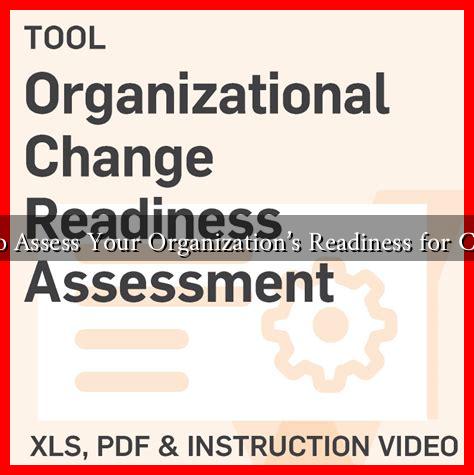-
Table of Contents
How to Assess Your Organization’s Readiness for Change
In today’s fast-paced business environment, organizations must adapt to survive and thrive. However, implementing change is not always straightforward. Assessing your organization’s readiness for change is a critical first step in ensuring successful transformation. This article will explore the key factors to consider when evaluating readiness for change, practical assessment methods, and real-world examples to illustrate these concepts.
Understanding Change Readiness
Change readiness refers to the extent to which an organization is prepared to implement change initiatives. It encompasses various dimensions, including organizational culture, employee engagement, and resource availability. Understanding these factors can help leaders identify potential barriers and enablers of change.
Key Factors to Assess
When assessing your organization’s readiness for change, consider the following key factors:
- Organizational Culture: A culture that embraces innovation and flexibility is more likely to support change initiatives. Assess whether your organization values adaptability and continuous improvement.
- Leadership Support: Change initiatives require strong leadership. Evaluate whether leaders are committed to the change and willing to allocate necessary resources.
- Employee Engagement: Employees’ attitudes towards change can significantly impact its success. Gauge employee sentiment through surveys or focus groups to understand their readiness.
- Communication Channels: Effective communication is vital for change management. Assess whether your organization has established clear channels for disseminating information about the change.
- Resource Availability: Determine if your organization has the necessary resources—financial, human, and technological—to support the change initiative.
Methods for Assessing Readiness
There are several methods organizations can use to assess their readiness for change:
- Surveys and Questionnaires: Conduct anonymous surveys to gather insights from employees about their perceptions of the upcoming change. Questions can focus on their understanding of the change, perceived benefits, and concerns.
- Focus Groups: Organize focus group discussions with diverse employee representatives to delve deeper into their feelings and attitudes towards the change.
- SWOT Analysis: Perform a SWOT analysis (Strengths, Weaknesses, Opportunities, Threats) to identify internal and external factors that may impact the change initiative.
- Change Readiness Assessment Tools: Utilize established frameworks and tools, such as the Change Readiness Assessment Model, to systematically evaluate readiness across various dimensions.
Real-World Examples
Several organizations have successfully assessed their readiness for change, leading to effective transformations:
- IBM: In the early 2000s, IBM faced significant market changes. The company conducted extensive employee surveys to gauge readiness for a shift towards cloud computing. By understanding employee concerns and expectations, IBM was able to implement a successful transition.
- Procter & Gamble: P&G utilized focus groups to assess employee readiness for a new digital marketing strategy. The insights gained allowed them to tailor their training programs, resulting in a smoother implementation.
Statistics on Change Readiness
Research indicates that organizations that assess their readiness for change are more likely to succeed. According to a study by McKinsey & Company, companies that actively engage employees in the change process are 3.5 times more likely to outperform their peers in terms of financial performance. Additionally, a report from Prosci found that projects with excellent change management practices are six times more likely to meet objectives than those with poor practices.
Conclusion
Assessing your organization’s readiness for change is a crucial step in the change management process. By understanding key factors such as organizational culture, leadership support, and employee engagement, leaders can identify potential barriers and enablers of change. Utilizing various assessment methods, including surveys, focus groups, and SWOT analysis, can provide valuable insights into the organization’s readiness. Real-world examples demonstrate that organizations that prioritize readiness are more likely to achieve successful transformations.
In summary, taking the time to assess readiness not only prepares your organization for change but also fosters a culture of adaptability and resilience. For further reading on change management strategies, consider exploring resources from the Prosci Change Management website.


